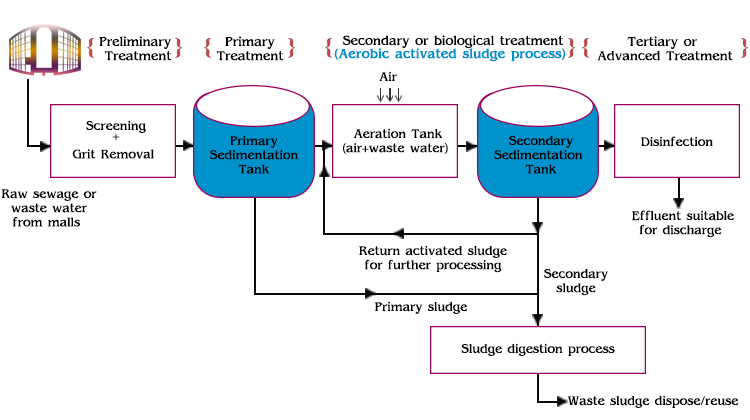Sewage Treatment Plant for Shopping Malls
Sewage Treatment Plant for Shopping Malls
Nowadays, sewage generation from big-sized malls has also been increased. Hence, the sewage must be treated and disposed of to avoid water and soil pollution matter. The impact of wastewater generated from malls on the environment is increasing day by day. Hence, it is necessary to implant sewage treatment plant in every shopping mall which produces a greater volume of wastewater.
Do you think is it necessary to treat sewage from malls?
Well! The answer is obviously YES. Because, if you fail to treat sewage it can harm human health and the natural environment. Hence, it is necessary to treat wastewater/sewage from the shopping malls before it is reused/recycled and or discharged into the environment.

What kind of treatment methods involved in STP?
Commercial package sewage treatment plant includes physical, chemical and biological methods.
a. Physical method: It consists of sedimentation, screening, filtration, skimming and etc.
b. Chemical method: It consists of chlorination, neutralization, coagulation, etc.
c. Biological method: It consists of aerobic (activated sludge process, tricking filters, oxidation pond, aerated lagoons, aerobic digestion etc.,) and anaerobic (anaerobic digestion, septic tanks etc.,) processes.
The detailed description of each treatment level in Sewage Treatment Plant is shown below:

Sewage Treatment Process:
Different levels of sewage treatment:
Wastewater/sewage generated from various units of the malls flows to the commercial sewage treatment system via sewer lines. Different levels of treatment involved during the treatment process are as follows:
1. Preliminary Treatment Level
2. Primary Treatment Level
3. Secondary Treatment Level
4. Tertiary Treatment Level
Level 1: Preliminary Treatment or pretreatment:
1. Its main objective is to prevent damage to plant equipments/parts by removing water constituents that found in raw sewage or wastewater.
2. Being a first treatment level, it removes easily separable large suspended solids (rags, bottles, cups, cans, and many such) and other materials (oils, etc.,) from incoming wastewater called influent.
3. In this level, bar screens are used for screening and hence more percentage of suspended solids are removed.
4. It uses a grit chamber to remove an excess amount of grit, sand and small stones will settle to the bottom of the chamber.
5. The quality of the effluent obtained at the end of this treatment is not acceptable and hence it should be subjected to further levels of wastewater treatment.
Level 2: Primary Treatment:
1. This is the treatment that needs to be done before the wastewater is subjected to a secondary treatment level or biological treatment.
2. Pretreated wastewater flows into a sedimentation tank or primary clarifiers which use chemicals like flocculants and coagulants.
3. To encourage sedimentation process the flow of wastewater is reduced and hence heavier suspended solids settle to the bottom of the tank and lighter particles rise to the surface and are skimmed off.
4. The settled solids are called as primary sludge which will be treated in a later stage and the residual liquid is now subjected to the next level of treatment.
5. Primary treatment of sewage/wastewater removes approximately 60-65% of suspended solids.
Level 3: Secondary or biological treatment:
1. It involves both aerobic and anaerobic biological treatment where the aerobic process called the “activated sludge process” is the most commonly used process to reduce organic material.
2. Waste water flows from the primary tank and will enter into the aeration tank where air is supplied to increase the growth of microorganisms like bacteria to break down organic matter.
3. Now aerated wastewater (solids + microorganisms) enters into secondary clarifiers in which heavier solids settle to the bottom of the clarifiers which is called secondary sludge.
4. Some of the sludge will be redirected to the aeration tank for further processing and the remaining mixes with primary sludge for the sludge digestion process and then disposed of or reused.
5. This stage ensures about 80-85% of organic matter is removed.
Level 4: Tertiary or advanced treatment:
1. This is the highest or final treatment level in most of the Sewage Treatment Plants (STP).
2. The main objective of this treatment level is to produce better quality effluent which was not obtained during previous levels.
3. Depending on the quality of the effluent it involves physical chemical or biological methods to remove leftover suspended and dissolved solids.
4. It involves disinfection process to remove residual microorganisms from wastewater before its discharge or reuse.
5. Disinfection is done by using disinfectants like chlorine, ozone, UV light, and many such, and now treated wastewater called effluent is suitable for discharge into the environment or reuse.
Sewage treatment processes remove a variety of toxins and harmful disease-causing contaminants from sewage/wastewater to make it usable again or to dispose off.
Sewage treatment plants play a crucial role in safeguarding public health by ensuring a reliable supply of clean and safe drinking water, as well as protecting the environment by treating and returning wastewater responsibly.
Sintech Engineering Solutions is an Importer and manufacturer of Water Treatment Plant (WTP) in Bangladesh.
Email: sales@sintechbd.com; Cell: 01829-675191
